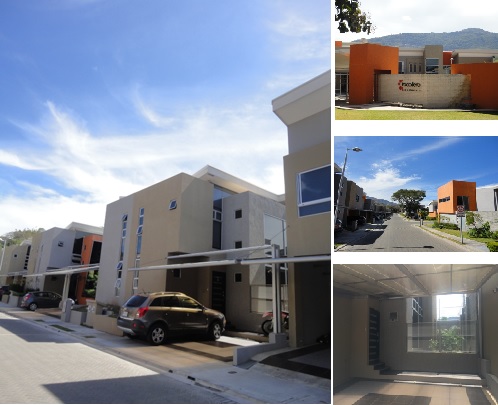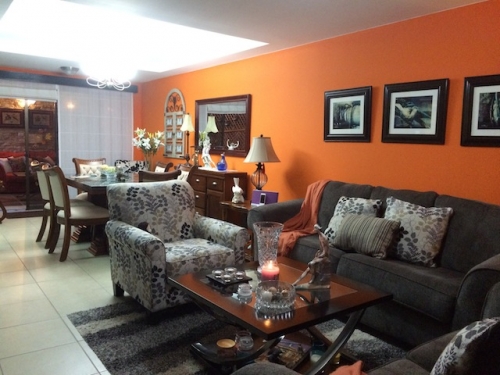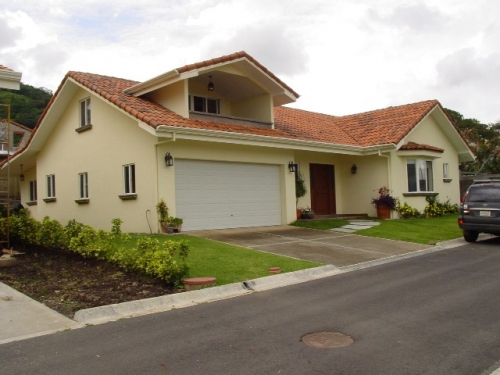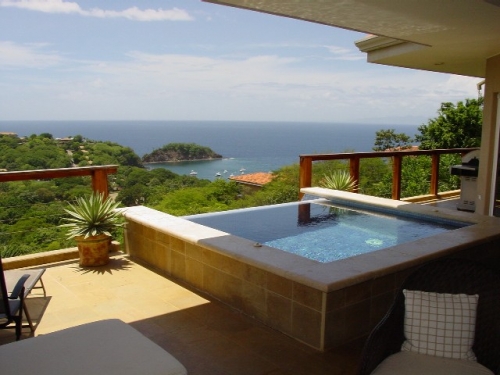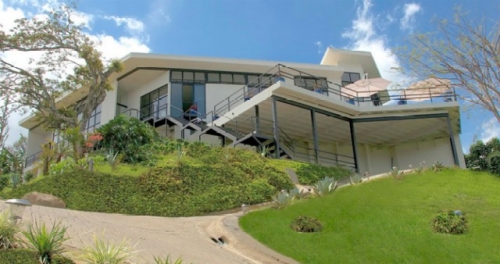Costa Rica Guide
Costa Rica Real Estate
List your property today!
Inclusion of real estate listings at Costa Rica Guide is
absolutely free of charge.
Featured Properties
Costa Rica Guide - Costa Rica Real Estate
Volcanoes, beaches and monkeys, oh my
Get close to nature and savor the good life during a family adventure to Central America's eco-wonderland
By George Jordan
Newark Star-Ledger
December 4, 2006
In Costa Rica, the Spanish phrase ¡Pura vida! is the national saying, a catchall phrase that means "the good life.''
We first experienced its meaning in Vega, a lazy town perched on a winding mountain road on the edge of a cloud forest at the start of an eight-day, cross-country car trip.
Vega sits high above a valley filled with billowing clouds that shroud the majestic Volcán Arena, one of the world's most active volcanoes, which daily erupts lava and stones the size of SUVs.
At dusk, golden sunlight illuminated the clouds in a visual masterpiece. It was as if the clouds were filled with a prehistoric light, almost as if a dinosaur might emerge from the flora and fauna, where colorful birds and howler monkeys make their presence known.
¡Pura vida!
The views from Vega were among many wonderful encounters with nature in this eco-wonderland that's home to 5 percent of the world's biodiversity, including a stunning array of birds, some so colorful they stop you in your tracks.
In eight days, our family of four hiked to the very edge of one of the world's largest active volcano craters, lounged in hot mineral springs, played golf, shopped at several art galleries, rode horses, took volcanic mud baths, rocketed 40 mph on zip lines 25 stories above the rain-forest floor, pulled a 75-pound dorado from the Pacific Ocean and frolicked on miles of pristine beach without seeing another tourist.
Travel to and from Costa Rica's 26 major nature reserves and parks is relatively easy in what is known as Latin America's "Switzerland" for its stable, democratically elected government, with universal health care and a high literacy rate.
Though we drove cross-country, we did not sleep in budget hotels. In every case, it was cheaper to rent a junior suite with a sofa bed at an upscale hotel than two rooms with full-size beds at less pricey establishments.
We flew into San José, the Costa Rican capital. We would return home from Liberia, a new international airport in northwest Costa Rica, about a 90-minute drive from the Nicaraguan border. (Continental Airlines offers nonstops to both cities from Houston.)
At Adobe Car Rental adjacent to the airport, we picked up a Mitsubishi Montero, and that full-size truck came in handy when we encountered teeth-jarring potholes, especially on the dirt road around Lake Arenal in central Costa Rica. Another caution: The two-lane mountain highways are treacherously steep.
We made two major highway trips for a total of 15 hours of driving. Driving in Costa Rica is not for the faint of heart, but the payoff in flexibility was worth the risk. Buy maps in advance — good ones are difficult to come by once you arrive.
We stopped at Grecia's old metal church, Sarchí's shops — where craftsmen make the famous ox carts of Costa Rica — and Zarcero, where large bushes and shrubs in the town square are trimmed into the shapes of animals. We also paused at Englishman Michael LeMay's garden, where he lovingly planted and maintains 2,500 tropical plants.
At Zoo Ave, an animal rescue facility 20 minutes northwest of San José in the upscale village of Alajuela, the $15 per person entry free (no child discount) was merited.
"Daddy, Daddy," the children squealed, running for cover as a 4-foot-long emerald-green iguana bolted up a bamboo tree near the perches of several colorful macaws. Every few feet there were tortoises or peacocks wandering along a trail lined with caged pumas and jaguars and exotic birds and monkeys.
We spent our first night at the Best Western Irazú, a casino hotel with a Denny's restaurant that serves a less-than-delicious version of American breakfast fare.
At sunrise, we drove three hours along well-paved roads to Volcán Poás, 8,200 feet above sea level. It was a one-mile hike from the visitors center to the crater, which offered a view of the steaming white sulfuric lake flanked by steam geysers in the bowels of the volcano.
The park's trails and picnic area feature several habitats: areas with scarce vegetation, a stunted forest and a cloud forest distinguished by mosses, bromeliads and the humus that covers the forest floor. There are 79 species of birds in this park, including hummingbirds and the quetzal, the national bird of Costa Rica.
A half-hour drive away from Poás is La Paz Waterfall Garden. Its huge butterfly and hummingbird observatory gives visitors a close encounter with the tiny birds, which can be hand-fed from straws filled with sugar water. The gardens are at the start of a trail leading to five powerful waterfalls.
We arrived at our next stop, the city of Fortuna and Tabacón Hot Springs Resort & Spa, at nightfall. Our terrace looked out on the rain forest and the mighty Arenal, which was obscured by clouds during our entire visit. Over the next three days, we would see just about every species of bird in our Costa Rican wildlife guides. Each day, we were jarred awake by the howler monkeys.
At night, we changed into swimsuits, pool shoes and Tabacón terry-cloth robes for a five-minute bus ride to the elaborately landscaped spa for a buffet dinner and a dip in the natural pools fed by waters heated by the volcano.
During the day, the hot springs operates the Isadora spa, which offers facials, volcanic mud baths and yoga. "It was the ultimate," my wife cooed after her 90-minute mud wrap.
In Fortuna, we ate delicious prawns at Las Brasitas and tender beef at NeNe's, where our server, Martino, explained how the rich soil around Arenal produces lush grasslands. "We have happy cows," he said.
Volcán Arenal powers both the biodiversity and tourist industry in the region. It is, indeed, living and breathing. There is no shortage of warnings at the volcano park entrance: "Danger. Enter at your own risk." The need for caution becomes obvious when Arenal speaks: Snap, crackle, pop, boom!
Smoking-hot boulders the size of Volkswagen Beetles regularly tumble down the cone, a view all the more unsettling from atop a lava flow that in 2002 cut a path through dense rain forest.
On the final day at Arenal, we paddled rafts on the Corobici River, which flows westward to the Pacific lowlands. Our guide, Andrés, pointed out bats, an eagle, crocodiles, piranha, howler monkeys and a seemingly endless variety of trees and plants.
By the tour's end, we realized we were not looking at the wildlife; we were being watched.
On the fourth day of the journey, we drove to Tamarindo on Costa Rica's Guanacaste Peninsula along the Pacific coast and stayed 30 minutes away at Hacienda Pinilla, a 4,500-acre former cattle ranch with some of the most private beaches in Costa Rica.
Hacienda Pinilla operates a small, moderately priced hotel for tourists — and potential home buyers — looking to experience the lifestyle of the rich and famous.
The four miles of unspoiled beach alone justified the expense of the stay. And the center of the property features one of the most remote and scenic 18-hole golf courses in the world.
From the surfer town of Tamarindo, we boarded the 31-foot Flamingo II deep-sea fishing boat for a half-day trip offered by Yellowfin Sports Charter.
Within an hour, the Spanish-speaking captain and crew member had lines in the water, and we were fighting tuna and dorado. We caught only a glimpse of the elusive blue marlin but took back to the hotel lots of tuna, which the chef grilled for dinner.
Our last day was spent shopping for pottery and exploring the beach before a leisurely horseback ride through the former ranch's dry rain forest.
We arrived on the beach just in time for a breathtaking sunset. And as the sun began its descent below the horizon, we saw the golden light again — the same liquid amber we saw at the start of our trip.
The light, so pure, washed over the crashing waves and thousands of shells that cover Playa Tamarindo.
¡Pura vida!
If you go
Getting there: Continental Airlines offers two daily nonstops each from Houston to San José and Liberia, Costa Rica.
Getting around: My family of four, including two children ages 14 and 10, booked all of our hotel rooms, the rental car and many of the tours and excursions in advance, though many travelers opt to find accommodations on the fly.
Cost and currency: The dollar goes a long way in Costa Rica. A good dinner can be had for around $12 per person, and a decent hotel room still runs from $60 to $90 a night, sometimes even less. There's no need to exchange dollars for Costa Rican colones. American currency is accepted by just about every store and restaurant at the same exchange rate as banks.
What to take
Among essentials for travelers in Costa Rica:
U.S. dollars are accepted everywhere. But finding an automatic teller that takes your card could be challenging outside San José.
Other needed items include binoculars, waterproof wildlife guides and a road map, even if you don't plan to rent a car.
Clothes should accommodate rain and wild temperature swings, sometimes within the same day. Bring a fleece top, rain poncho, hiking shoes, sandals and a wide-brimmed hat. Consider shirts and pants made of the lightweight cloth that wicks away perspiration, because they dry fast.
Laundry soap is a must to wash your T-shirts. String may be needed for a makeshift laundry line.
Zip-lock bags are used to store wet and dry items.
Preventive bug spray/lotion is a necessary item.
Other essentials include Band-Aids for hiker's sores, an antacid for sensitive stomachs and sinus/allergy medicine. After a long hike, your favorite balm for muscle aches is handy.
You will probably want one video or digital still camera, plus a smaller one to take on zip lines and into hot springs. Seriously consider equipment portability and weight when deciding what to take.
A plastic water bottle is needed for hiking.
Bubble Wrap can be used to pack away art objects and pottery.
Tiny flashlights can also be helpful items
Copyright 2006
Note: The above information is not to be used for any other purpose other than private study, research, criticism or review. Thank you.

